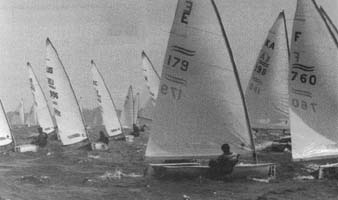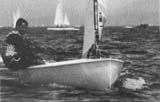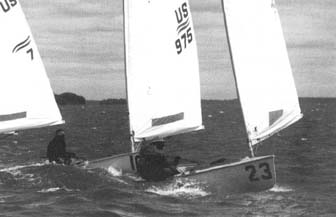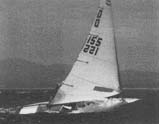Masts
Since the 1972 German Olympics, all of the top sailors in the class have
been using metal Needlespar 3M masts. All of the 3Ms are quite similar,
but since the Finn mast is unstayed, slight manufacturing variances can
significantly change bending characteristics. Finding a 'fast' mast is the
quest that most Finn sailors' dreams are made of. Most have experimented
with more than one mast. Bertrand has owned nine; Lewis has owned five.
Says Bertrand, "I don't measure bend characteristics like some people.
I have to see it on the boat to tell you if I like it or not." Lewis
agrees: "I'm not a parking lot sailor."
How does one determine what looks good under sail and what doesn't? According
to Bertrand, "The mast should work sideways when you are sailing upwind.
It is this 'fanning' or pumping of the top of the sail that is really fast."
Neff adds, "The mast should have good 'elasticity', allowing it to
spring right back when bent to leeward." Neff also mentioned that the
heavier you are, the stiffer the spar should be sideways.
For fore-and-aft bend, Bertrand says, "I look for an even bend, one
which matches the luff curve on my sail. The front of the sail should be
flat, while the leech is open and allowed to work."
Lewis also looks for a nice, even mast curve and suggests checking to be
sure the track is on straight. If not, it can often affect bend. For Neff,
the best spar is one which has an even curve in the top and bottom third,
with the centre third smoothly connecting those two.
Regardless of personal preferences, all stress the importance of finding
a spar that matches the luff curve of the sail. |
One necessary mast-related
change is the replacement of the aluminium mast collar with one made
of Delrin or HMW plastic. Although fairly expensive, it does considerably
reduce friction and provide a much tighter fit. Some, such as Menkart,
add a Teflon ring outside the Delrin collar. "The Teflon,"
says Menkart, "is attached to the hull, while the Delrin rides
snugly around the mast. In that way, the only friction is between
the Delrin and the Teflon, and that isn't much." Menkart also
suggests moving the mast as far forward as is possible at deck level
(on Vanguards it's usually only a centimetre or so) to provide a better
helm in a breeze. "I generally move the spar forward by cutting
a little out at the front end of the mast hole and making the Teflon
a little wider at the aft end says Menkart.
|
 |
|
Mast rake is measured with a tape from the hoisted halyard shackle to the
transom, and there is some disagreement among the five as to how to adjust
rake as conditions change. Bertrand and Menkart begin easing their masts
aft as the winds pick up, contending that it helps soften the leach, allowing
air to spill out of the sail easier. Neff and Lewis pull their masts forward
as the wind increases. According to Lewis, this gives them a flatter sail
and actually makes the sail a bit smaller by shortening the roach, taking
a little more cloth out of the back of the sail. Buchan leaves his set in
the same place all the time, contending that his speed in all conditions
is 'just fine'.
|
 |
Sails
Like hulls and spars, there is one sail that almost everyone agrees
on - the North T3+B design, made from 3.8 ounce cloth. Designed by
the Australian John Bertrand (hence the '+B') for the 1976 Olympics,
the sail has yet to be really improved on. With its optimum conditions
appearing in light to moderate winds, only Lewis uses another sail
when the wind picks up beyond that: "Once whitecaps begin to
appear, I usually switch over to a standard 3.8 ounce Deegan sail,
made by a New Zealander who owns a loft in Cowes, England. The Deegan
cloth feels firmer than the North," |
|
Controls
With five sail-shape controls, plus the centreboard pennant, all led aft
to the skipper, the Finn is an easy boat to adjust.
Outhaul - The outhaul controls the top third of the leech, opening
and closing it as the outhaul is tightened and loosened. All five frequently
adjust the outhaul on upwind legs, pulling the clew close to the black band
to depower the sail in heavy air and easing it away from the band when more
power is needed, such as in light air and/or chop. Care must be taken when
easing the outhaul, since a tight upper leech is very sensitive to wind
direction and stalls easily.
Cunningham - The Cunningham works similarly to the outhaul, but controls
the middle third of the leech. Generally, no one touches the Cunningham,
even if there are wrinkles along the luff, until they begin to get overpowered,
Then, the Cunningham is tightened, along with easing the traveller.
Inhaul - The inhaul controls the bottom third of the leech. On beats,
the inhaul is usually set and left alone unless there are major changes
in conditions. At starts, however, to decrease the angle of attack and allow
better pointing, the inhaul is usually eased away from the mast.
Mainsheet - Unlike boats with sidestays and forestays, easing the
mainsheet reduces leech tension and creates twist. As the boom comes off
the deck the mast goes forward and straightens out. According to Menkart, "the luff curve is built for a bent mast, which means the sail becomes
fuller and the draft moves forward as the mainsheet is eased."
Usually, it is important to have a sail with the draft aft rather than right
next to the mast. For this reason, the mainsheet is rarely eased to the
point where the boom is much more than a foot above deck level.
Vang - Upwind, the vang is set so that you can just fit under the boom
when tacking. This allows the sail to stay close to the optimum shape during
the tack. There is even a slight amount of vang used in zero to five knots,
mainly to keep the mast bent slightly.
Centreboard - Unlike boats with more efficient centreboards (such
as Lasers), the Finn's flat-plate board is generally kept all the way down
upwind, regardless of conditions. And unlike Lasers, Finns will steer with
practically no board down at all, so offwind, the board is usually raised,
although for stability, most only raise it part way. Says Buchan, "Downwind,
you should pull the board up as much as you dare." In really heavy
winds, the boat may start oscillating, and once it starts, a death roll
or roundup to windward is usually imminent, unless you get the board back
down. On reaches, the board is lowered only enough to keep the boat from
sideslipping.
|
Boat handling,
Steering and Sheeting
Bertrand, Buchan, Lewis, Menkart and Neff all have spent so much time
in Finns that boat handling, steering and sheeting are instinctive.
Consequently, obtaining specifics about certain techniques is difficult,
as most of the time these five are simply into the rhythm of the race
rather than specifically thinking about technique. However, a few
points do stand out. Upwind, Bertrand tries not to steer too much,
because he feels the flat, thin centreboard stalls out easily. For
Menkart, upwind sailing speed, particularly in gusty conditions, hinges
on his ability to effectively depower. "Since the Cunningham
has such a drastic effect on leech tension, I use it to depower the
sail. A lot of people sail Lasers without side cleats, but there's
no way you can sail a Finn that way. The sail pulls too hard, and
you just have to leave it cleated, especially in a breeze. However,
I do play the main in light and medium winds, easing it for power,
such as when going through waves, and tightening it for speed."
|
 |
|
|
Offwind, Buchan mentions that when he has been out of the Finn for some
time, he has trouble regaining the 'near-disaster' groove necessary to
attain top speed. "When running," he says, "it seems the
closer you are to rolling to weather, the faster you go." For Neff,
a major factor in offwind speed is vang tension, and he sees a close relationship
between it and the ability to catch waves. "Generally," says
Neff, "I carry the vang looser on a reach than on a run, and when
I miss a wave I think I should have caught, I ease the vang some more."
|
 |
Lewis
is the most outspoken about the absolute necessity of making every
move second nature by simply getting out and sailing a lot. Once the
moves are down, the next step, according to Lewis, is to learn as
much as you can about where you're going to be sailing, or better
yet, spend some time sailing there.
All agreed that Finn sailors must be strong and have a lot of stamina.
Says Menkart, "Offwind in a lot of breeze, it is much faster
to take the main 1:1 from the boom, but that's tough. And when you
jibe, it gets even tougher. Once the boom crosses and the sail fills,
it tugs so hard that it feels like it's going to pull you right out
of the boat." |
|
|
Similarly, body movement is very important in the class. Since all five
sailors have strong Laser backgrounds, many movements and big-fleet tactics
from that class have filtered into the Finn. But with the Finn weighing
319 pounds, compared to the Laser's 130, and the Finn's sail area totalling
115 square feet to the Laser's 75, some Laser movements are simply not
as effective in the Finn. But they do provide enough of an edge to enable
these five sailors to continually finish in the forefront of international
Finn competition.
Finn Philosophy
Bertrand: "Often, someone is very fast during the first five minutes
of sail testing or during the first third of the windward leg. But when
it takes something extra to withstand the pain and still be aggressive,
people often begin to fade. One thing you learn when sailing Finns is
that you have to develop the ability to be scrapping all the time."
Buchan: "A lot of people need to work harder at having good speed
right at the start. At the start, I'm often sailing hard and well into
the race while others are still making adjustments. I try to get all my
testing done before the race. That gives me confidence that, after a good
start, I can stay in clear wind."
Lewis: "The only
things that help win sailboat races are sailing smart, time on the water
and time around the buoys."
Neff: "I'm afraid a Finn sail is only at its peak from the second
to the seventh or eighth regatta, After that, it gets slower. Many people
I'm sailing against would go better if they simply bit the bullet and
bought a new sail more frequently."
Menkart: "Too many have a fear of basic Finn manoeuvres, such as
jibing. I did, too, when I first started. But it's really not that hard,
especially if you remember to ease the vang. However, a survival jibe
- that is, just staying upright through the manoeuvre - is easy. A good
jibe is tough and simply takes a lot of practice time."
And by the same token, good Finn sailing is tough, for the fraternity
of Finn sailors are in a league by themselves as far as ability and physical
endurance are concerned. But like all other things, you only get out of
Finn sailing what you put into it.
|
|